小升初英语通用版介词和连词课件
图片预览
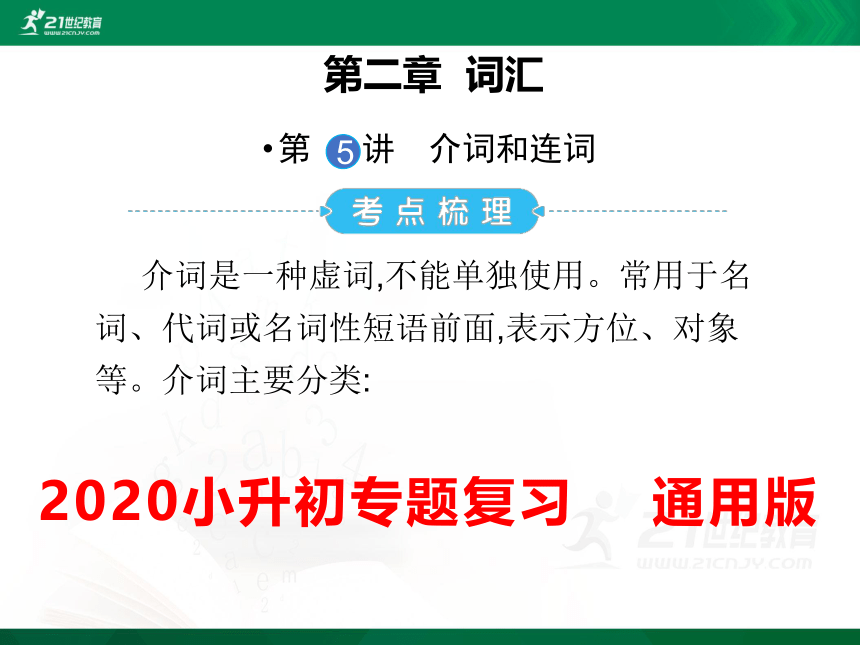
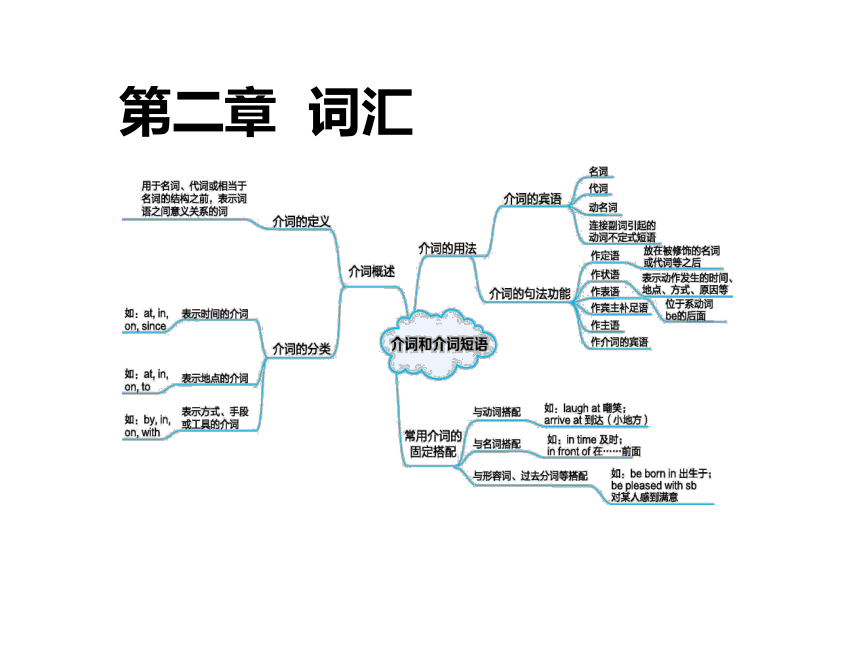
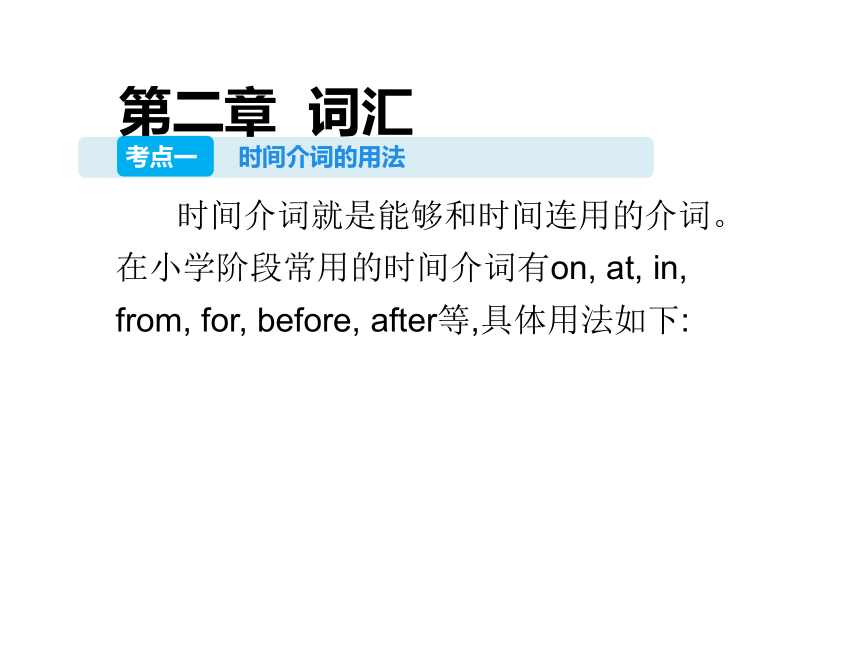

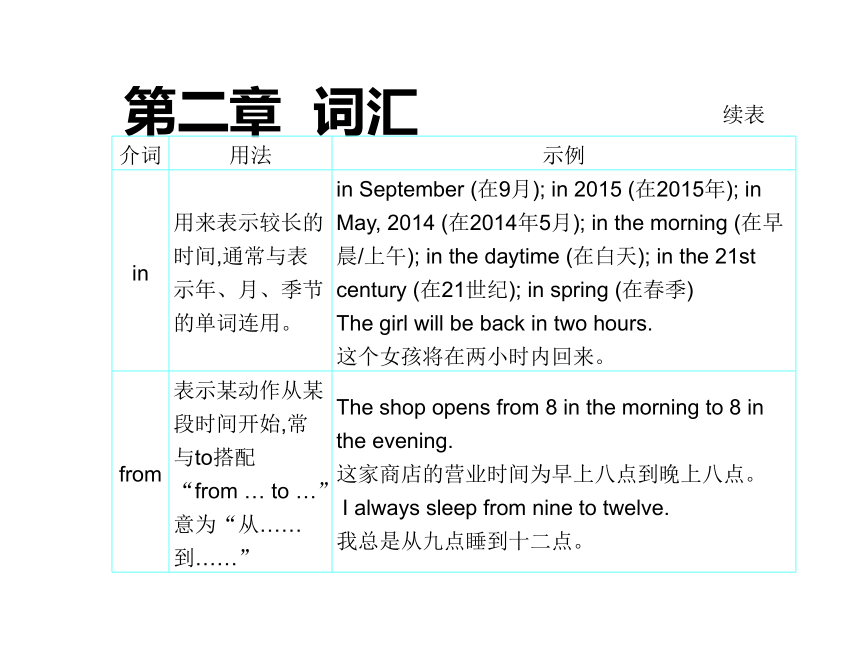
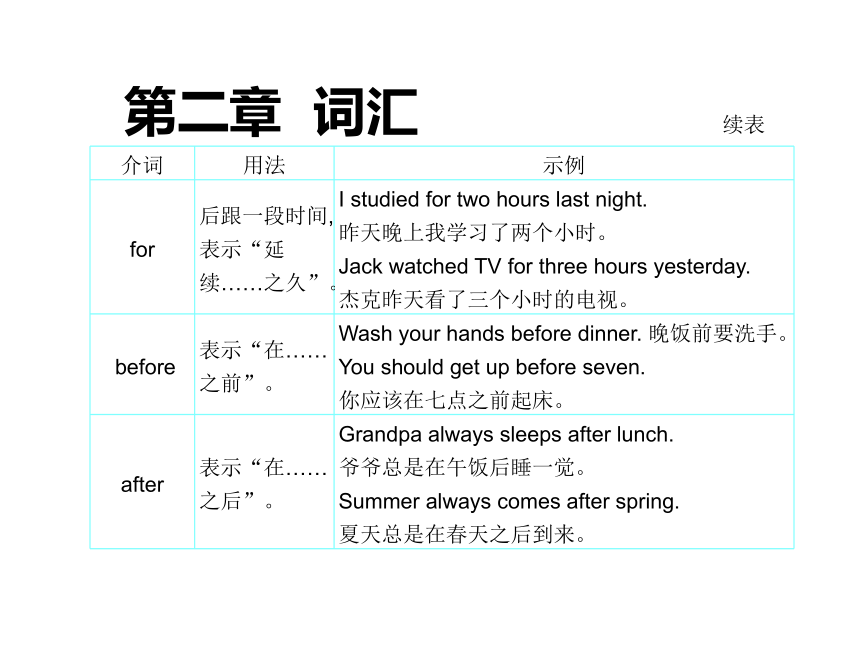
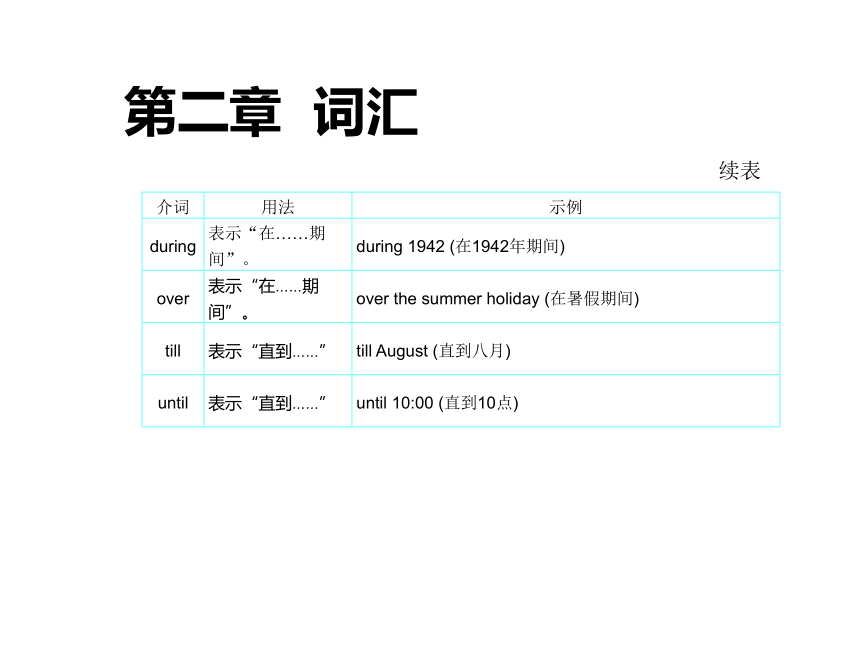
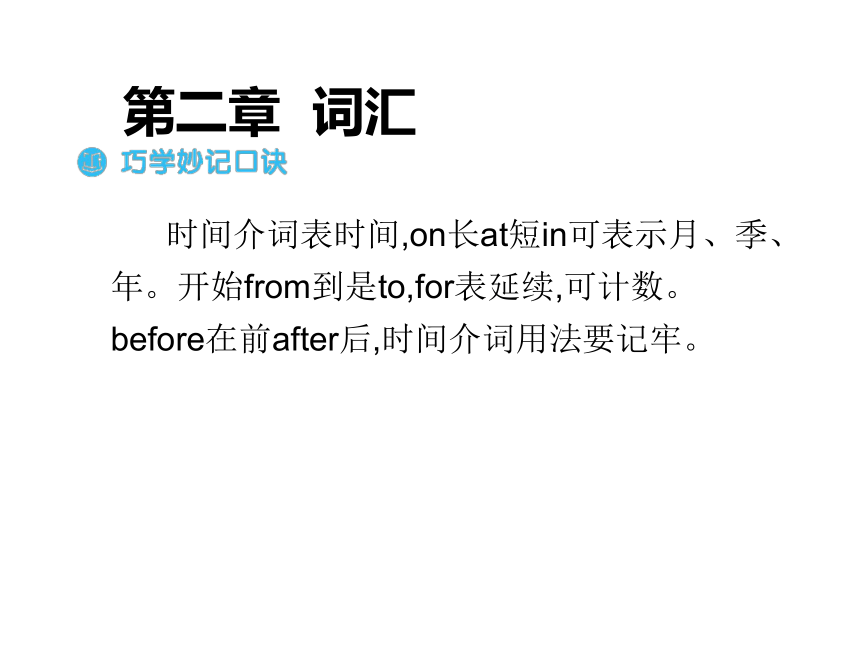
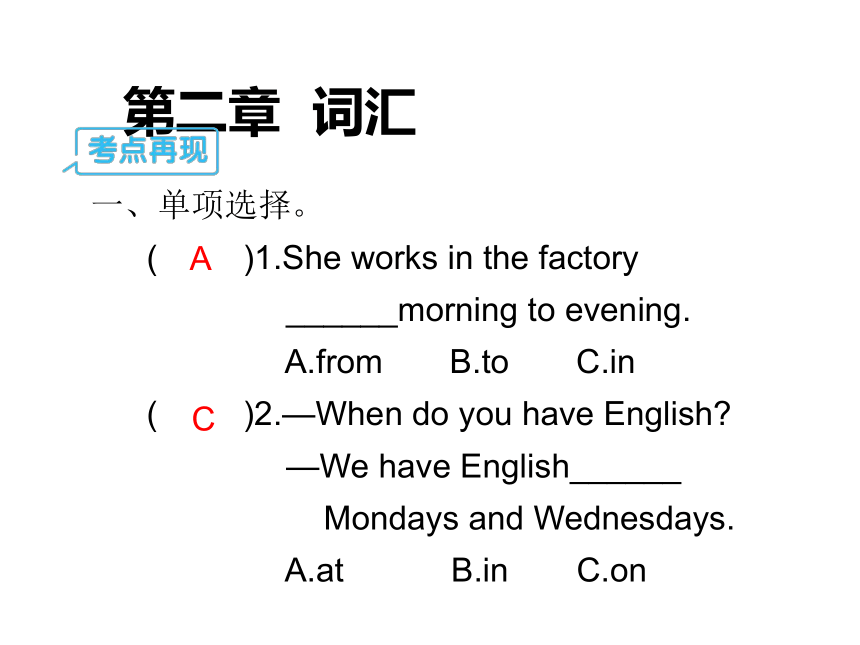
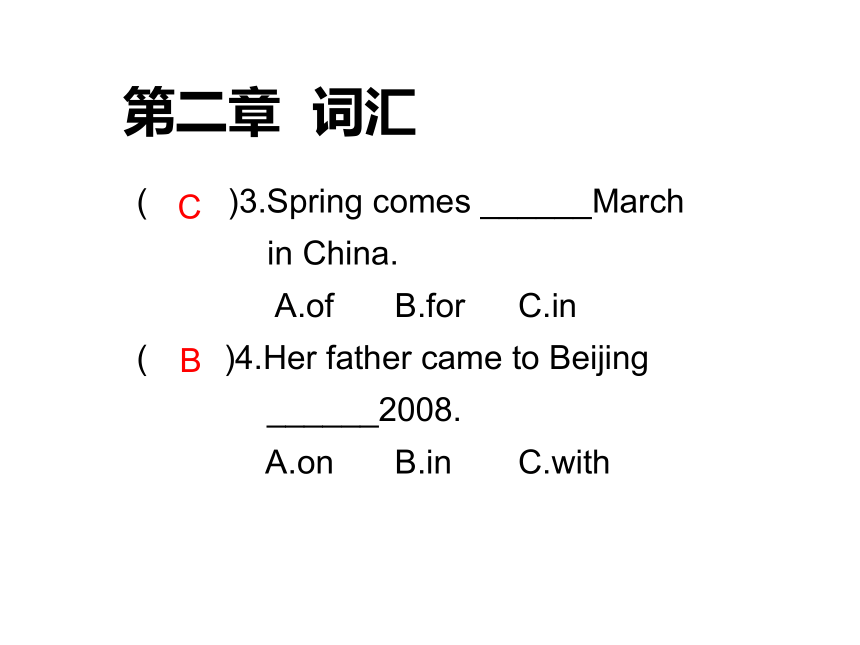
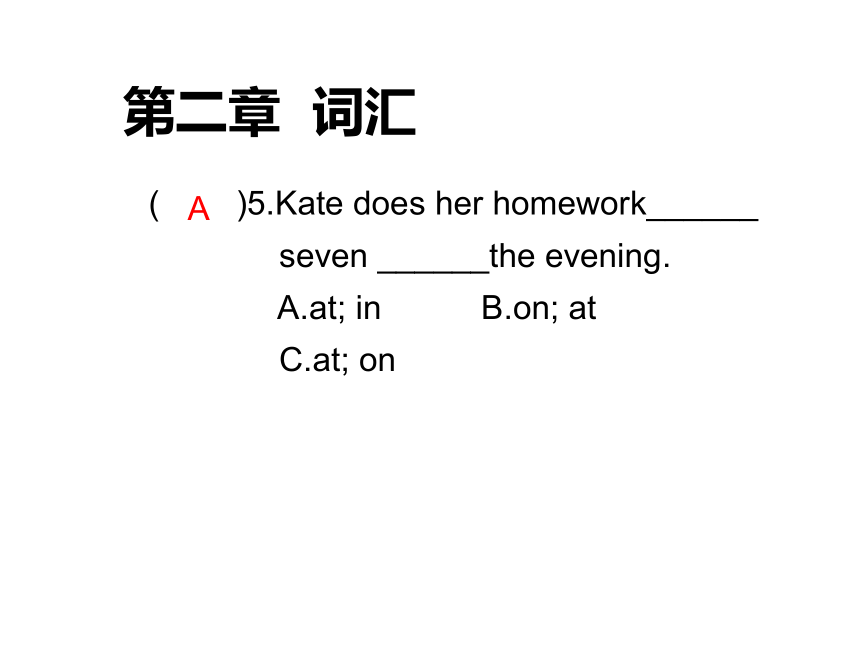
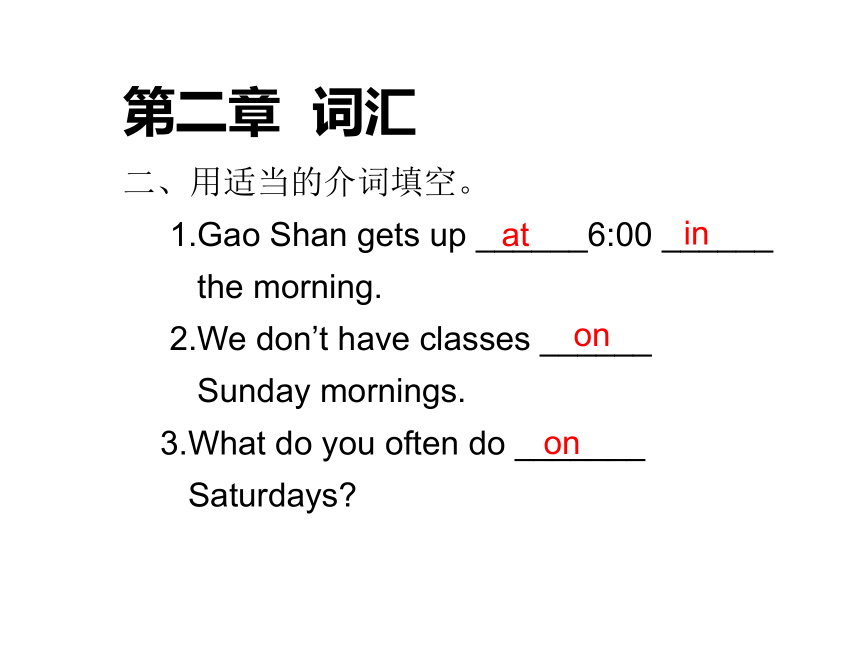
文档简介
第二章 词汇
第 讲 介词和连词
5
介词是一种虚词,不能单独使用。常用于名词、代词或名词性短语前面,表示方位、对象等。介词主要分类:
2020小升初专题复习 通用版
第二章 词汇
第二章 词汇
考点一
时间介词的用法
时间介词就是能够和时间连用的介词。在小学阶段常用的时间介词有on, at, in, from, for, before, after等,具体用法如下:
第二章 词汇
介词
用法
示例
on
表示在具体的某一天或某一天的某个时间。
on Sunday morning (在星期日早晨/上午); on the second of May (在5月2日); on Sunday (在星期日);
on a December night (在12月的一个夜晚); on that afternoon (在那天下午); on October 1st, 1949 (在1949年10月1日); on New Year’s Day (在元旦); on the morning of the 15th (在15日的早上/上午)
I will watch TV on Monday afternoon.
我将在星期一下午看电视。
at
表示在某一具体的时刻或用于正午、黄昏、午夜前。
at five o’clock (在五点); at dawn (在黎明); at sunrise
在日出时); at noon (在中午); at midnight (在半夜);
at the beginning of the month (在月初); at that time
(那时); at that moment (那会儿)He arrived at 7 o’clock. 他七点到的。
第二章 词汇
介词
用法
示例
in
用来表示较长的时间,通常与表示年、月、季节的单词连用。
in September (在9月); in 2015 (在2015年); in May, 2014 (在2014年5月); in the morning (在早晨/上午); in the daytime (在白天); in the 21st century (在21世纪); in spring (在春季)
The girl will be back in two hours.
这个女孩将在两小时内回来。
from
表示某动作从某段时间开始,常与to搭配“from … to …”意为“从……到……”
The shop opens from 8 in the morning to 8 in the evening.
这家商店的营业时间为早上八点到晚上八点。
I always sleep from nine to twelve.
我总是从九点睡到十二点。
续表
第二章 词汇
介词
用法
示例
for
后跟一段时间,表示“延续……之久”。
I studied for two hours last night.
昨天晚上我学习了两个小时。
Jack watched TV for three hours yesterday.
杰克昨天看了三个小时的电视。
before
表示“在……之前”。
Wash your hands before dinner. 晚饭前要洗手。
You should get up before seven.
你应该在七点之前起床。
after
表示“在……之后”。
Grandpa always sleeps after lunch.
爷爷总是在午饭后睡一觉。
Summer always comes after spring.
夏天总是在春天之后到来。
续表
第二章 词汇
介词
用法
示例
during
表示“在……期间”。
during 1942 (在1942年期间)
over
表示“在……期间”。
over the summer holiday (在暑假期间)
till
表示“直到……”
till August (直到八月)
until
表示“直到……”
until 10:00 (直到10点)
续表
第二章 词汇
时间介词表时间,on长at短in可表示月、季、年。开始from到是to,for表延续,可计数。
before在前after后,时间介词用法要记牢。
一、单项选择。
( )1.She works in the factory
______morning to evening.?
A.from B.to C.in
( )2.—When do you have English?
—We have English______
Mondays and Wednesdays.?
A.at B.in C.on
第二章 词汇
A
C
( )3.Spring comes ______March
in China.?
A.of B.for C.in
( )4.Her father came to Beijing
______2008.
A.on B.in C.with
第二章 词汇
C
B
第二章 词汇
( )5.Kate does her homework______
seven ______the evening.?
A.at; in B.on; at
C.at; on
A
二、用适当的介词填空。
1.Gao Shan gets up ______6:00 ______
the morning.?
2.We don’t have classes ______
Sunday mornings.?
3.What do you often do _______
Saturdays??
第二章 词汇
at
in
on
on
4.He works _______March to June in a year.?
5.Winter comes _______autumn.?
6.My parents get up _______six thirty every
morning.?
7.We have lunch ______noon. 8.There are seven days ______a week.?
9.His birthday is ______May 21st.
10.I often pick apples ______October.?
第二章 词汇
from
after
at
at
in
on
in
第二章 词汇
考点二
地点代词的用法
地点介词是指可以和表示地点的名词连用的介词。具体用法如下:
介词
用法
例句
at
常常表示位于较小的地点,意为“在……”
I will meet you at the station. 我将在车站接你。
所指范围不太明显,表示“在……附近,旁边”。
The ball is at the corner.
球在角落里。
第二章 词汇
介词
用法
例句
in
主要用来表示在某物的里面,同时又表示位于较宽广的地点,意为“在……”
The pens are in the pencil box.
钢笔在铅笔盒里。
They live in the suburbs.
他们住在郊区。
指大地方
When I was young, I lived in Beijing. 我小时候住在北京。
表示“在……范围之内”(是从属关系)。
Shandong is in the east of China.
山东在中国的东部。
to
表示“在……范围外”,强调不接壤,不相邻。
Japan is to the east of China.
日本在中国的东面。
续表
第二章 词汇
介词
用法
例句
on
意为“在……上”,表示某物和另一物体表面相接触。
He was lying on the bed.
他正躺在床上。
表示毗邻,接壤(是相邻关系)。
Jiangxi is on the east of Hunan. 江西在湖南的东面。
above
表示“在……上方”,不强调是否在正上方。
The bird is flying above my head. 一只鸟在我的头顶上飞翔。
over
表示“在……正上方”,与物体有一定的空间,不直接接触。
There is a bridge over the river. 河上有一座桥。
under
表示“在……正下方”。
There is a ball under the bed.
床底下有一个球。
续表
第二章 词汇
介词
用法
例句
below
表示“在……下面”,不一定在正下方。
Please write your name below the line. 请在横线下写上你的名字。
near
表示“在……附近”。
The post office is near the bank.
邮局在银行附近。
next
表示“紧挨着”。
It’s next to the cinema.
它紧挨着电影院。
behind
指“在……后面”。
He stood behind me.
他站在我身后。
beside
表示“在……旁边”。
The cat is beside the desk.
猫在书桌旁边。
续表
第二章 词汇
续表
介词
用法
例句
between
表示“在……中间”。
The bookstore is between the school and the park.
书店在学校和公园中间。
from
表示从某个起点开始,即“从……来; 来自……”
He is from Australia.
他来自澳大利亚。
along
表示“沿着……”
Go along this street and turn left at the second crossing.
沿着这条街走,在第二个十字路口向左拐。
第二章 词汇
续表
介词
用法
例句
up
表示由下而上的动作方向,意为“向上; 沿着……向上”。
He jumped up from his chair.
他从椅子上跳了起来。
down
表示由上而下的动作方向,意为“向下; 沿着……向下”。
A man came down the stairs to meet them. 一个男人走下台阶迎接他们。
into
进来;进去
She walked into the room.
她走进了房间。
out
从……里面出去
Get out of the room! 从房间里出去!
第二章 词汇
根据汉语意思完成句子。
1.她住在南京路。
She lives ______Nanjing Road.?
2.10点她将到达上海。
She will arrive ______Shanghai at ten.?
3.格林湖是他家附近的一个小湖。
Green Lake is a small lake ______his home.?
on
in
near
第二章 词汇
4.房子前面有一辆小汽车。
There is a car in ______of the house.?
5.他坐在我后面。He sat _______me.?
6.在公交车站等我。
Wait for me ______the bus stop.?
7.猴子正在往树上爬。
The monkey is climbing ______the tree.?
front
behind
at
up
第二章 词汇
8.她从楼梯上摔了下来。
She fell ______the stairs.?
9.让我们沿着街散散步吧!
Let’s walk ______the street!?
10.我的笔友来自加拿大。
My pen pal is ______Canada.?
down
along
from
第二章 词汇
考点三
表示方式、手段 或工具等介词的用法
介词
用法
例句
by+交通工具类名词
表示“乘坐……”
Shall we go to Beijing by plane?
我们乘飞机去北京,好吗?
by+动词-ing 形式
表示“通过某种方式”
You can be a good student by working hard.
通过努力学习你可以成为一名好学生。
in+语言类名词
表示“用……语言”
What’s this in English?
这个用英语怎么说?
Please say it in Chinese.请用汉语说。
第二章 词汇
介词
用法
例句
in+材料类名词
表示“用……材料”
The teacher writes in blue ink.
老师用蓝墨水写字。
with+名词
用某种工具、身体的某个部位或器官,通常用于具体的事物。
We can see with eyes.
我们可以用眼睛看。
Cut the apples with the knife.
用刀切苹果。
续表
第二章 词汇
by 在前,工具后,交通工具要说明;
说什么语言要用in, 材料也可后面跟;
with多用于身体,四肢五官有意义。
第二章 词汇
单项选择。
( )1.I love talking with her ______
English.?
A.with B.in C.by
( )2.The dolls are made ______hand.?
A.by B.on C.at
B
A
第二章 词汇
( )3.Please write it ______ink.?
A.at B.with C.in
( )4.He makes a living ______teaching.?
A.with B.by C.in
( )5.Jenny goes to school ______bike.?
A.by B.in C.with
C
B
A
第二章 词汇
考点四
其他用法
介词
用法
示例
of
表示所属关系“……的”
a friend of my parents
我父母的一个朋友
表示“……之中”
four boys of the team
小组里的四个男孩
表示计量、时间或年龄
a pair of shoes一双鞋;
the fourth of July 七月四日;
a girl of 12 一名12岁的女孩
第二章 词汇
介词
用法
示例
for
为了……(表示目的、利益等)
What can I do for you?
我能为你做点什么?
由于、因为
Thank you for your help.
谢谢你的帮助。
like
像……一样
They are like brother and sister. 他们情同兄妹。
……怎么样
What will the weather be like tomorrow?
明天的天气怎么样?
at
对着……
Please look at the blackboard.
请看黑板。
续表
第二章 词汇
介词
用法
示例
to
对于; 给
Please send some food to them.
请给他们送些食物。
in
穿着; 戴着
Tom is in a purple hat.
姆戴着一顶紫色的帽子。
about
表示“关于;对于”
She knew a lot about food.
她对食品懂得很多。
around
表示“在……四周”
She looked at the newspapers around her.
她看了看她四周的报纸。
续表
根据汉语意思把句子补充完整。
1.这本书的封皮很漂亮。
The cover_______ this book is very nice. ?
2.给我一把切面包的刀子。
Give me a knife______ cutting bread. ?
第二章 词汇
of
for
3.请把这张明信片寄给我。
Please send this postcard ______me. ?
4.埃米收到了一封她姨妈的来信。
Amy got a letter______ her aunt. ?
5.那个穿黑衣服的男人是谁?
Who is the man ______black? ?
第二章 词汇
to
from
in
第二章 词汇
【示例1】 ( )The cat is the tree.?
A.on B.in
C.at D.\
【精析】 “on the tree”意为“(叶子、果实等)长在树上”,“in the tree”意为“(外来物等)在树上”,而“at the tree”搭配错误,因此,选项B正确。
【答案】B
( )The apples ______the tree are
red and big.?
A.in B.at
C.on D.up
第二章 词汇
【针对性练习1】
C
第二章 词汇
【示例2】 ( )Where are you going _____
this afternoon??
A.on B.in C.at D.\
【精析】句意: 今天下午你去哪里? this afternoon 为固定词组,意为“今天下午”,因为带有指示代词,所以前面不用再加介词。因此A,B,C项都可排除。
【答案】D
( )We are going to visit the
museum ______tomorrow.?
A.\ B.at
C.in D.on
第二章 词汇
【针对性练习2】
A
第二章 词汇
【精析】本题考查介词“by”,表示“乘坐某种交通
工具或以……方式”。乘公共汽车用介词
“by”,可知答案为A。
【示例3】 ( )Mary went to school______
bus yesterday.?
A.by B.with C.on D.at
【答案】A
( )Shall we go to Beijing______
plane??
A.buy B.by
C.on D.with
第二章 词汇
【针对性练习3】
B
第二章 词汇
连词
连词是一种虚词, 不能独立承担句子成分,它只起连接词与词、短语与短语以及句子与句子的作用。常见的连词有and, but, so, because等。连词按意义可分为并列连词和从属连词两大类。小学阶段我们主要接触到了并列连词。
第二章 词汇
考点一
并列连词
并列连词用来连接平行的单词、词组和句子,这种关系是对等关系,具体用法如下:
分类
连词
意义
例句
并列关系
and
意思是“和”,用在肯定句中。
He and I are students.
他和我是学生。
or
意思是“和”, 用在否定句中。
I don’t like reading or swimming.
我既不喜欢读书,也不喜欢游泳。
both …
and …
意思是“两者都……”
Both she and I like eating apples.
她和我都喜欢吃苹果。
第二章 词汇
分类
连词
意义
例句
因果关系
for
意思是“因为”,对前面的内容进行解释。
He is good at maths, for he studies harder than others.他擅长数学,因为他学习比别人努力。
so
意思是“所以”,表示结果。
It’s cold outside, so I should put on my coat.
外面很冷,所以我应该穿上我的外套。
选择关系
or
意思是“或者”,用在疑问句中。
Do you often go to school on foot or by bike?
你是经常步行还是骑自行车去上学?
续表
第二章 词汇
分类
连词
意义
例句
并列关系
and
意思是“和”,用在肯定句中。
He and I are students.
他和我是学生。
or
意思是“和”, 用在否定句中。
I don’t like reading or swimming.
我既不喜欢读书,也不喜欢游泳。
both …
and …
意思是“两者都……”
Both she and I like eating apples.
她和我都喜欢吃苹果。
续表
第二章 词汇
并列连词连接词和句,谁和谁用“and”,表示转折用“but”;
“因此,所以”要用“so”, “for”是“因为”放句中;
表示选择要用“or”,但是否定句中表并列。
根据汉语意思完成下列句子。
1.我有一个哥哥和一个姐姐。
I have a brother ______a sister.?
2.天很晚了,所以我们回家了。
It is very late, ______we go home.?
第二章 词汇
and
so
3.埃米和萨拉都很忙。
______ Amy______ Sarah are very busy.?
4.你喜欢咖啡还是茶?
Do you like coffee ______tea??
5.这只风筝很漂亮,但是我不喜欢。
This kite is nice,
______I don’t like it.
第二章 词汇
Both
and
or
but
第二章 词汇
从属连词主要用于引导从句。
考点二
从属连词
连词
用法
例句
after
意思是“在……之后”,引导时间状语从句。
I will tell you after they leave.
他们走后我再告诉你。
before
意思是“在……之前”,引导时间状语从句。
Please turn the lights off before you leave.
离开前请关灯。
第二章 词汇
连词
用法
例句
when
意思是“当……的时候”,引导时间状语从句。
He jumped up when the phone rang.
电话铃响时他吓得跳了起来。
if
意思是“如果”,引导条件状语从句。
If you have a fever, you may have the flu.
如果你发烧了,你有可能得了流感。
because
意思是“因为”,引导原因状语从句。
Because I was ill, I didn’t go to school yesterday.
因为生病,我昨天没有去上学。
续表
第二章 词汇
从属连词连句子,学得不多要牢记;
当你想说某个时候,就用“when”来代替;
“因为”是“because”,但和“so”没有联系;
“假设,如果”是“if”,表示情况是虚拟。
单项选择。
( )1.We’ll stay at home _____it
rains tomorrow.?
A.so B.when C.if
( )2.He didn’t say anything _____
he left.?
A.before B.if C.so
第二章 词汇
C
A
( )3.I found her bag _____she left.?
A.after B.although C.because
( )4.I was painting the wall _____
he called me.?
A.after B.when C.before
( )5.Cathy didn’t go to school
_____she was ill.?
A.because B.if C.so
第二章 词汇
A
B
A
第二章 词汇
【示例1】 ( )我喜欢语文和英语,但我不喜
欢体育和历史。
A.I like Chinese and English,
but I don’t like PE and history.
B.I like Chinese and English,
but I don’t like PE or history.
第二章 词汇
【精析】在肯定句中,并列成分之间用“and”
来连接;而在否定句中,并列成分之间
用“or”连接。
【答案】B
( )Would you like to eat fish
______vegetables??
A.so B.but
C.or D.for
第二章 词汇
【针对性练习1】
C
第二章 词汇
【示例2】 ( )______ I am ill, ______I
want to see the doctor.?
A.Because; so
B.So; because
C.For; so
D.\; so
第二章 词汇
【精析】通过题目和选项内容,我们可以猜测句
意为“因为我生病了,所以我想去看
医生”。“because”和“so”在一
个句中不能同时出现;而“for”表示
原因时不能放句首,因此可以排除选
项 A,B,C,从而得出答案。
【答案】D
第二章 词汇
【针对性练习2】
( )We love spring, ______there’re
beautiful flowers everywhere.?
A.and B.but
C.so D.because
D
谢谢
21世纪教育网(www.21cnjy.com) 中小学教育资源网站
有大把高质量资料?一线教师?一线教研员?
欢迎加入21世纪教育网教师合作团队!!月薪过万不是梦!!
详情请看:
https://www.21cnjy.com/help/help_extract.php
第 讲 介词和连词
5
介词是一种虚词,不能单独使用。常用于名词、代词或名词性短语前面,表示方位、对象等。介词主要分类:
2020小升初专题复习 通用版
第二章 词汇
第二章 词汇
考点一
时间介词的用法
时间介词就是能够和时间连用的介词。在小学阶段常用的时间介词有on, at, in, from, for, before, after等,具体用法如下:
第二章 词汇
介词
用法
示例
on
表示在具体的某一天或某一天的某个时间。
on Sunday morning (在星期日早晨/上午); on the second of May (在5月2日); on Sunday (在星期日);
on a December night (在12月的一个夜晚); on that afternoon (在那天下午); on October 1st, 1949 (在1949年10月1日); on New Year’s Day (在元旦); on the morning of the 15th (在15日的早上/上午)
I will watch TV on Monday afternoon.
我将在星期一下午看电视。
at
表示在某一具体的时刻或用于正午、黄昏、午夜前。
at five o’clock (在五点); at dawn (在黎明); at sunrise
在日出时); at noon (在中午); at midnight (在半夜);
at the beginning of the month (在月初); at that time
(那时); at that moment (那会儿)He arrived at 7 o’clock. 他七点到的。
第二章 词汇
介词
用法
示例
in
用来表示较长的时间,通常与表示年、月、季节的单词连用。
in September (在9月); in 2015 (在2015年); in May, 2014 (在2014年5月); in the morning (在早晨/上午); in the daytime (在白天); in the 21st century (在21世纪); in spring (在春季)
The girl will be back in two hours.
这个女孩将在两小时内回来。
from
表示某动作从某段时间开始,常与to搭配“from … to …”意为“从……到……”
The shop opens from 8 in the morning to 8 in the evening.
这家商店的营业时间为早上八点到晚上八点。
I always sleep from nine to twelve.
我总是从九点睡到十二点。
续表
第二章 词汇
介词
用法
示例
for
后跟一段时间,表示“延续……之久”。
I studied for two hours last night.
昨天晚上我学习了两个小时。
Jack watched TV for three hours yesterday.
杰克昨天看了三个小时的电视。
before
表示“在……之前”。
Wash your hands before dinner. 晚饭前要洗手。
You should get up before seven.
你应该在七点之前起床。
after
表示“在……之后”。
Grandpa always sleeps after lunch.
爷爷总是在午饭后睡一觉。
Summer always comes after spring.
夏天总是在春天之后到来。
续表
第二章 词汇
介词
用法
示例
during
表示“在……期间”。
during 1942 (在1942年期间)
over
表示“在……期间”。
over the summer holiday (在暑假期间)
till
表示“直到……”
till August (直到八月)
until
表示“直到……”
until 10:00 (直到10点)
续表
第二章 词汇
时间介词表时间,on长at短in可表示月、季、年。开始from到是to,for表延续,可计数。
before在前after后,时间介词用法要记牢。
一、单项选择。
( )1.She works in the factory
______morning to evening.?
A.from B.to C.in
( )2.—When do you have English?
—We have English______
Mondays and Wednesdays.?
A.at B.in C.on
第二章 词汇
A
C
( )3.Spring comes ______March
in China.?
A.of B.for C.in
( )4.Her father came to Beijing
______2008.
A.on B.in C.with
第二章 词汇
C
B
第二章 词汇
( )5.Kate does her homework______
seven ______the evening.?
A.at; in B.on; at
C.at; on
A
二、用适当的介词填空。
1.Gao Shan gets up ______6:00 ______
the morning.?
2.We don’t have classes ______
Sunday mornings.?
3.What do you often do _______
Saturdays??
第二章 词汇
at
in
on
on
4.He works _______March to June in a year.?
5.Winter comes _______autumn.?
6.My parents get up _______six thirty every
morning.?
7.We have lunch ______noon. 8.There are seven days ______a week.?
9.His birthday is ______May 21st.
10.I often pick apples ______October.?
第二章 词汇
from
after
at
at
in
on
in
第二章 词汇
考点二
地点代词的用法
地点介词是指可以和表示地点的名词连用的介词。具体用法如下:
介词
用法
例句
at
常常表示位于较小的地点,意为“在……”
I will meet you at the station. 我将在车站接你。
所指范围不太明显,表示“在……附近,旁边”。
The ball is at the corner.
球在角落里。
第二章 词汇
介词
用法
例句
in
主要用来表示在某物的里面,同时又表示位于较宽广的地点,意为“在……”
The pens are in the pencil box.
钢笔在铅笔盒里。
They live in the suburbs.
他们住在郊区。
指大地方
When I was young, I lived in Beijing. 我小时候住在北京。
表示“在……范围之内”(是从属关系)。
Shandong is in the east of China.
山东在中国的东部。
to
表示“在……范围外”,强调不接壤,不相邻。
Japan is to the east of China.
日本在中国的东面。
续表
第二章 词汇
介词
用法
例句
on
意为“在……上”,表示某物和另一物体表面相接触。
He was lying on the bed.
他正躺在床上。
表示毗邻,接壤(是相邻关系)。
Jiangxi is on the east of Hunan. 江西在湖南的东面。
above
表示“在……上方”,不强调是否在正上方。
The bird is flying above my head. 一只鸟在我的头顶上飞翔。
over
表示“在……正上方”,与物体有一定的空间,不直接接触。
There is a bridge over the river. 河上有一座桥。
under
表示“在……正下方”。
There is a ball under the bed.
床底下有一个球。
续表
第二章 词汇
介词
用法
例句
below
表示“在……下面”,不一定在正下方。
Please write your name below the line. 请在横线下写上你的名字。
near
表示“在……附近”。
The post office is near the bank.
邮局在银行附近。
next
表示“紧挨着”。
It’s next to the cinema.
它紧挨着电影院。
behind
指“在……后面”。
He stood behind me.
他站在我身后。
beside
表示“在……旁边”。
The cat is beside the desk.
猫在书桌旁边。
续表
第二章 词汇
续表
介词
用法
例句
between
表示“在……中间”。
The bookstore is between the school and the park.
书店在学校和公园中间。
from
表示从某个起点开始,即“从……来; 来自……”
He is from Australia.
他来自澳大利亚。
along
表示“沿着……”
Go along this street and turn left at the second crossing.
沿着这条街走,在第二个十字路口向左拐。
第二章 词汇
续表
介词
用法
例句
up
表示由下而上的动作方向,意为“向上; 沿着……向上”。
He jumped up from his chair.
他从椅子上跳了起来。
down
表示由上而下的动作方向,意为“向下; 沿着……向下”。
A man came down the stairs to meet them. 一个男人走下台阶迎接他们。
into
进来;进去
She walked into the room.
她走进了房间。
out
从……里面出去
Get out of the room! 从房间里出去!
第二章 词汇
根据汉语意思完成句子。
1.她住在南京路。
She lives ______Nanjing Road.?
2.10点她将到达上海。
She will arrive ______Shanghai at ten.?
3.格林湖是他家附近的一个小湖。
Green Lake is a small lake ______his home.?
on
in
near
第二章 词汇
4.房子前面有一辆小汽车。
There is a car in ______of the house.?
5.他坐在我后面。He sat _______me.?
6.在公交车站等我。
Wait for me ______the bus stop.?
7.猴子正在往树上爬。
The monkey is climbing ______the tree.?
front
behind
at
up
第二章 词汇
8.她从楼梯上摔了下来。
She fell ______the stairs.?
9.让我们沿着街散散步吧!
Let’s walk ______the street!?
10.我的笔友来自加拿大。
My pen pal is ______Canada.?
down
along
from
第二章 词汇
考点三
表示方式、手段 或工具等介词的用法
介词
用法
例句
by+交通工具类名词
表示“乘坐……”
Shall we go to Beijing by plane?
我们乘飞机去北京,好吗?
by+动词-ing 形式
表示“通过某种方式”
You can be a good student by working hard.
通过努力学习你可以成为一名好学生。
in+语言类名词
表示“用……语言”
What’s this in English?
这个用英语怎么说?
Please say it in Chinese.请用汉语说。
第二章 词汇
介词
用法
例句
in+材料类名词
表示“用……材料”
The teacher writes in blue ink.
老师用蓝墨水写字。
with+名词
用某种工具、身体的某个部位或器官,通常用于具体的事物。
We can see with eyes.
我们可以用眼睛看。
Cut the apples with the knife.
用刀切苹果。
续表
第二章 词汇
by 在前,工具后,交通工具要说明;
说什么语言要用in, 材料也可后面跟;
with多用于身体,四肢五官有意义。
第二章 词汇
单项选择。
( )1.I love talking with her ______
English.?
A.with B.in C.by
( )2.The dolls are made ______hand.?
A.by B.on C.at
B
A
第二章 词汇
( )3.Please write it ______ink.?
A.at B.with C.in
( )4.He makes a living ______teaching.?
A.with B.by C.in
( )5.Jenny goes to school ______bike.?
A.by B.in C.with
C
B
A
第二章 词汇
考点四
其他用法
介词
用法
示例
of
表示所属关系“……的”
a friend of my parents
我父母的一个朋友
表示“……之中”
four boys of the team
小组里的四个男孩
表示计量、时间或年龄
a pair of shoes一双鞋;
the fourth of July 七月四日;
a girl of 12 一名12岁的女孩
第二章 词汇
介词
用法
示例
for
为了……(表示目的、利益等)
What can I do for you?
我能为你做点什么?
由于、因为
Thank you for your help.
谢谢你的帮助。
like
像……一样
They are like brother and sister. 他们情同兄妹。
……怎么样
What will the weather be like tomorrow?
明天的天气怎么样?
at
对着……
Please look at the blackboard.
请看黑板。
续表
第二章 词汇
介词
用法
示例
to
对于; 给
Please send some food to them.
请给他们送些食物。
in
穿着; 戴着
Tom is in a purple hat.
姆戴着一顶紫色的帽子。
about
表示“关于;对于”
She knew a lot about food.
她对食品懂得很多。
around
表示“在……四周”
She looked at the newspapers around her.
她看了看她四周的报纸。
续表
根据汉语意思把句子补充完整。
1.这本书的封皮很漂亮。
The cover_______ this book is very nice. ?
2.给我一把切面包的刀子。
Give me a knife______ cutting bread. ?
第二章 词汇
of
for
3.请把这张明信片寄给我。
Please send this postcard ______me. ?
4.埃米收到了一封她姨妈的来信。
Amy got a letter______ her aunt. ?
5.那个穿黑衣服的男人是谁?
Who is the man ______black? ?
第二章 词汇
to
from
in
第二章 词汇
【示例1】 ( )The cat is the tree.?
A.on B.in
C.at D.\
【精析】 “on the tree”意为“(叶子、果实等)长在树上”,“in the tree”意为“(外来物等)在树上”,而“at the tree”搭配错误,因此,选项B正确。
【答案】B
( )The apples ______the tree are
red and big.?
A.in B.at
C.on D.up
第二章 词汇
【针对性练习1】
C
第二章 词汇
【示例2】 ( )Where are you going _____
this afternoon??
A.on B.in C.at D.\
【精析】句意: 今天下午你去哪里? this afternoon 为固定词组,意为“今天下午”,因为带有指示代词,所以前面不用再加介词。因此A,B,C项都可排除。
【答案】D
( )We are going to visit the
museum ______tomorrow.?
A.\ B.at
C.in D.on
第二章 词汇
【针对性练习2】
A
第二章 词汇
【精析】本题考查介词“by”,表示“乘坐某种交通
工具或以……方式”。乘公共汽车用介词
“by”,可知答案为A。
【示例3】 ( )Mary went to school______
bus yesterday.?
A.by B.with C.on D.at
【答案】A
( )Shall we go to Beijing______
plane??
A.buy B.by
C.on D.with
第二章 词汇
【针对性练习3】
B
第二章 词汇
连词
连词是一种虚词, 不能独立承担句子成分,它只起连接词与词、短语与短语以及句子与句子的作用。常见的连词有and, but, so, because等。连词按意义可分为并列连词和从属连词两大类。小学阶段我们主要接触到了并列连词。
第二章 词汇
考点一
并列连词
并列连词用来连接平行的单词、词组和句子,这种关系是对等关系,具体用法如下:
分类
连词
意义
例句
并列关系
and
意思是“和”,用在肯定句中。
He and I are students.
他和我是学生。
or
意思是“和”, 用在否定句中。
I don’t like reading or swimming.
我既不喜欢读书,也不喜欢游泳。
both …
and …
意思是“两者都……”
Both she and I like eating apples.
她和我都喜欢吃苹果。
第二章 词汇
分类
连词
意义
例句
因果关系
for
意思是“因为”,对前面的内容进行解释。
He is good at maths, for he studies harder than others.他擅长数学,因为他学习比别人努力。
so
意思是“所以”,表示结果。
It’s cold outside, so I should put on my coat.
外面很冷,所以我应该穿上我的外套。
选择关系
or
意思是“或者”,用在疑问句中。
Do you often go to school on foot or by bike?
你是经常步行还是骑自行车去上学?
续表
第二章 词汇
分类
连词
意义
例句
并列关系
and
意思是“和”,用在肯定句中。
He and I are students.
他和我是学生。
or
意思是“和”, 用在否定句中。
I don’t like reading or swimming.
我既不喜欢读书,也不喜欢游泳。
both …
and …
意思是“两者都……”
Both she and I like eating apples.
她和我都喜欢吃苹果。
续表
第二章 词汇
并列连词连接词和句,谁和谁用“and”,表示转折用“but”;
“因此,所以”要用“so”, “for”是“因为”放句中;
表示选择要用“or”,但是否定句中表并列。
根据汉语意思完成下列句子。
1.我有一个哥哥和一个姐姐。
I have a brother ______a sister.?
2.天很晚了,所以我们回家了。
It is very late, ______we go home.?
第二章 词汇
and
so
3.埃米和萨拉都很忙。
______ Amy______ Sarah are very busy.?
4.你喜欢咖啡还是茶?
Do you like coffee ______tea??
5.这只风筝很漂亮,但是我不喜欢。
This kite is nice,
______I don’t like it.
第二章 词汇
Both
and
or
but
第二章 词汇
从属连词主要用于引导从句。
考点二
从属连词
连词
用法
例句
after
意思是“在……之后”,引导时间状语从句。
I will tell you after they leave.
他们走后我再告诉你。
before
意思是“在……之前”,引导时间状语从句。
Please turn the lights off before you leave.
离开前请关灯。
第二章 词汇
连词
用法
例句
when
意思是“当……的时候”,引导时间状语从句。
He jumped up when the phone rang.
电话铃响时他吓得跳了起来。
if
意思是“如果”,引导条件状语从句。
If you have a fever, you may have the flu.
如果你发烧了,你有可能得了流感。
because
意思是“因为”,引导原因状语从句。
Because I was ill, I didn’t go to school yesterday.
因为生病,我昨天没有去上学。
续表
第二章 词汇
从属连词连句子,学得不多要牢记;
当你想说某个时候,就用“when”来代替;
“因为”是“because”,但和“so”没有联系;
“假设,如果”是“if”,表示情况是虚拟。
单项选择。
( )1.We’ll stay at home _____it
rains tomorrow.?
A.so B.when C.if
( )2.He didn’t say anything _____
he left.?
A.before B.if C.so
第二章 词汇
C
A
( )3.I found her bag _____she left.?
A.after B.although C.because
( )4.I was painting the wall _____
he called me.?
A.after B.when C.before
( )5.Cathy didn’t go to school
_____she was ill.?
A.because B.if C.so
第二章 词汇
A
B
A
第二章 词汇
【示例1】 ( )我喜欢语文和英语,但我不喜
欢体育和历史。
A.I like Chinese and English,
but I don’t like PE and history.
B.I like Chinese and English,
but I don’t like PE or history.
第二章 词汇
【精析】在肯定句中,并列成分之间用“and”
来连接;而在否定句中,并列成分之间
用“or”连接。
【答案】B
( )Would you like to eat fish
______vegetables??
A.so B.but
C.or D.for
第二章 词汇
【针对性练习1】
C
第二章 词汇
【示例2】 ( )______ I am ill, ______I
want to see the doctor.?
A.Because; so
B.So; because
C.For; so
D.\; so
第二章 词汇
【精析】通过题目和选项内容,我们可以猜测句
意为“因为我生病了,所以我想去看
医生”。“because”和“so”在一
个句中不能同时出现;而“for”表示
原因时不能放句首,因此可以排除选
项 A,B,C,从而得出答案。
【答案】D
第二章 词汇
【针对性练习2】
( )We love spring, ______there’re
beautiful flowers everywhere.?
A.and B.but
C.so D.because
D
谢谢
21世纪教育网(www.21cnjy.com) 中小学教育资源网站
有大把高质量资料?一线教师?一线教研员?
欢迎加入21世纪教育网教师合作团队!!月薪过万不是梦!!
详情请看:
https://www.21cnjy.com/help/help_extract.php
